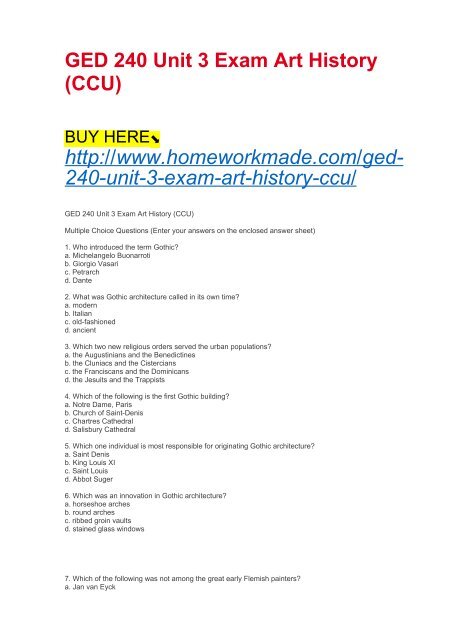GED 240 Unit 3 Exam Art History (CCU)
Create successful ePaper yourself
Turn your PDF publications into a flip-book with our unique Google optimized e-Paper software.
<strong>GED</strong> <strong>240</strong> <strong>Unit</strong> 3 <strong>Exam</strong> <strong>Art</strong> <strong>History</strong><br />
(<strong>CCU</strong>)<br />
BUY HERE⬊<br />
http://www.homeworkmade.com/ged-<br />
<strong>240</strong>-unit-3-exam-art-history-ccu/<br />
<strong>GED</strong> <strong>240</strong> <strong>Unit</strong> 3 <strong>Exam</strong> <strong>Art</strong> <strong>History</strong> (<strong>CCU</strong>)<br />
Multiple Choice Questions (Enter your answers on the enclosed answer sheet)<br />
1. Who introduced the term Gothic?<br />
a. Michelangelo Buonarroti<br />
b. Giorgio Vasari<br />
c. Petrarch<br />
d. Dante<br />
2. What was Gothic architecture called in its own time?<br />
a. modern<br />
b. Italian<br />
c. old-fashioned<br />
d. ancient<br />
3. Which two new religious orders served the urban populations?<br />
a. the Augustinians and the Benedictines<br />
b. the Cluniacs and the Cistercians<br />
c. the Franciscans and the Dominicans<br />
d. the Jesuits and the Trappists<br />
4. Which of the following is the first Gothic building?<br />
a. Notre Dame, Paris<br />
b. Church of Saint-Denis<br />
c. Chartres Cathedral<br />
d. Salisbury Cathedral<br />
5. Which one individual is most responsible for originating Gothic architecture?<br />
a. Saint Denis<br />
b. King Louis XI<br />
c. Saint Louis<br />
d. Abbot Suger<br />
6. Which was an innovation in Gothic architecture?<br />
a. horseshoe arches<br />
b. round arches<br />
c. ribbed groin vaults<br />
d. stained glass windows<br />
7. Which of the following was not among the great early Flemish painters?<br />
a. Jan van Eyck
. Rogier van der Weyden<br />
c. Robert Campin<br />
d. Paolo Uccello<br />
8. How were medieval and Renaissance women artists most likely to learn their trade if they couldn’t learn from<br />
a family member?<br />
a. convent<br />
b. apprenticeship<br />
c. art academy<br />
d. university<br />
9. Two influences on the work of Hugo van der Goes are the work of:<br />
a. Jan van Eyck and Rogier van der Weyden<br />
b. Petrus Christus and the Limbourg brothers<br />
c. Martin Schongauer and Antonio del Pollaiuolo<br />
d. Masaccio and Fra Angelico<br />
10. Which is a process where lines are cut into a plate with a burin and the low areas are printed?<br />
a. aquatint<br />
b. engraving<br />
c. woodcut<br />
d. lithography<br />
11. From which trade did engraving apparently develop, a trade practiced by Schongauer’s father?<br />
a. banker<br />
b. woodworker<br />
c. mason<br />
d. goldsmith<br />
12. Where was the birthplace of the Italian Renaissance?<br />
a. Rome<br />
b. Siena<br />
c. Venice<br />
d. Florence<br />
13. Which four artists define the High Renaissance?<br />
a. Raphael, Leonardo, Michelangelo, and Titian<br />
b. Donatello, Botticelli, Raphael, and Leonardo<br />
c. Donatello, Mantegna, Masaccio, and Michelangelo<br />
d. Raphael, Donatello, Masaccio, and Brunelleschi<br />
14. Which of the following interests of Leonardo occupied much of his time when he worked for the court of the<br />
Duke of Milan?<br />
a. military and civil engineer<br />
b. painter<br />
c. sculptor<br />
d. musician<br />
15. What is the word for strong contrasts of light and dark on an object?<br />
a. sfumato<br />
b. chiaroscuro<br />
c. trompe l’oeil<br />
d. grisaille<br />
16. Which is the term for the effect in painting of softer or smoky edges?<br />
a. chiaroscuro<br />
b. tenebrism<br />
c. sfumato<br />
d. impasto<br />
17. Which artist’s influence is particularly strong in the work of Raphael?<br />
a. Titian<br />
b. Botticelli<br />
c. Mantegna<br />
d. Perugino
18. Which is the term for a painting or drawing used as a model or pattern for another work?<br />
a. cartoon<br />
b. hemicycle<br />
c. sketch<br />
d. illumination<br />
19. Which is true of the subject of the pietà?<br />
a. Michelangelo’s is the first one.<br />
b. It was common in Northern Europe.<br />
c. It was common in Italy.<br />
d. Michelangelo’s is the only one.<br />
20. Which of the following best describes Mesoamerican society?<br />
a. sharply divided class structure<br />
b. egalitarian<br />
c. communistic<br />
d. democratic<br />
21. Which ancient Americans made the most accurate calendar?<br />
a. Olmec<br />
b. Aztec<br />
c. Nazca<br />
d. Maya<br />
22. What is the crest on the top of a Mayan temple called?<br />
a. Chacmool<br />
b. Roof comb<br />
c. Talud-tablero<br />
d. Formline<br />
23. Which of the following was the largest city in the Americas?<br />
a. Chichén Itzá<br />
b. Teotihuacan<br />
c. Cahokia<br />
d. Machu Picchu<br />
24. Which figure is represented on the Temple of the Feathered Serpent with a square, stylized head,<br />
protruding upper jaw, huge, round eyes (originally inlaid with obsidian), and large, circular earspools?<br />
a. Jaguar<br />
b. Corn god<br />
c. Tobacco god<br />
d. Storm god<br />
25. When the Aztecs saw an eagle perching on a prickly pear cactus, what did it mean to them?<br />
a. A human sacrifice was required.<br />
b. They should settle there.<br />
c. It foretold military success.<br />
d. The sun setting on the earth.<br />
<strong>Unit</strong> 3 <strong>Exam</strong>ination 130 <strong>GED</strong> <strong>240</strong> <strong>Art</strong> <strong>History</strong><br />
Writing Assignment for <strong>Unit</strong> Three<br />
3. Describe the typical characteristics of Mannerism and explain in what ways these characteristics<br />
appear, or do not appear, in Pontormo’s work.

















